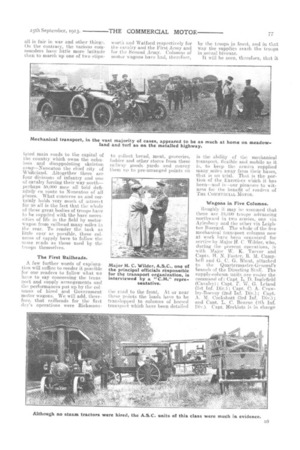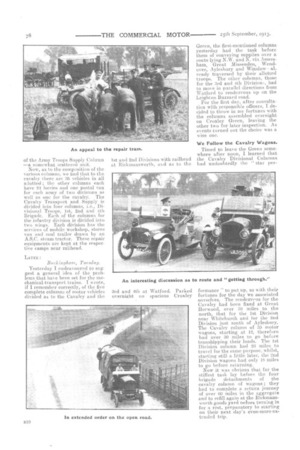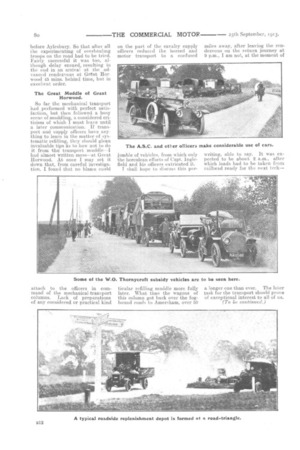Britain' s Motor Manceuvres.
Page 4

Page 5

Page 6

Page 7

Page 8

If you've noticed an error in this article please click here to report it so we can fix it.
Perhaps the Most Important Feature of the 1913 Army Exercises, Now Proceeding, is the Great Test of Mechanical Transport from Railhead to the Troops at the Front.
Our First Report Tells of a Tangle that Arose from "Mixed" TraYfic.
Illustrated Exclusively by " CM." Photos.
GREAT HORW OOD , oaday, 22nd September.
To those who, like the writer, are nowadays only brought occasionally into contact with an army in being, the sight of its vast network of organization in the field invariably creates several very vivid impressions which to the professional " soldier man " may perhaps not make any such appeal. First and foremost is a renewed realization of the really wonderful complexity of the vast great fighting machine ; then there is yearly-increasing surprise at the disciplined hordes of non-combatants whose existence is necessary in order to enable the man with the gun to go to the front.
The Army and its Stomach.
There are perhaps two more outstanding convictions with which the layman is assailed. One is the complete ignorance of what is going on elsewhere on the part of individual units and their ability nevertheless to sustain some semblance of intelligent participation in the great war game. Lastly, there is the obvious conclusion that the present exercises are petrol manoeuvres—both in the air and on land ; airmen, motorcycle scouts, headquarters and directing staffs, transport and supply, travelling workshops, ambulances, mailvans, wireless telegraphy, all depend on motor spirit for their being. The army teoday hardly moves so much upon its stomach as upon its petrol can.
Communications, not Outposts.
None but those who have seen troops at work in the field can possibly realize the existence of sclid miles of baggage trains, great long columns of mechanical transport,
thousands of -horses and wagons crammed with only the necessary impedimenta to enable the actual fighting troops to be physically fit and suitably dispositioned to fight. We ourselves are, of course, but little concerned with the military tactical value of the exercises and manoeuvres, excepting in so far as they necessitate modifications of transport organization. Our duties, accordingly, when "following manoeuvres," keep us, as a rule, well to the rear of the actual fighting lines ; we are a deal more interested in railhead than in outposts. As a consequence we are continually being faced with the magnitude of that portion of the army organization which has nothing to do with "fighting the foe," but of which the principal duty is to collect and carry the bread and meat, the horse-fodder and hundred and one other supplies and stores—with, in fact, the all-important lines and maintenance of communications. Then in addition there are numberless auxiliary branches to consider, increasing as they are each year in technical application as each leap forward is made in applied mechanical science.
We therefore are but little concerned--and we must confess as little interested—in the precise nature of the quarrel between Brownland, Whitelanol and Greenland, nor in their last physical efforts to bring things to an issue. To a proper understanding, however, of the part which the motor wagon is playing in these 1913 Exercises, it is necessary briefly to consider what the various fighting forces are endeavouring to do.
A Settled Programme.
This autumn we do not find army pitted against army with hands so free as to confirm once again that all is fair in war and other things. On the contrary, the various commanders have little more latitude than to march up one of two stipu
lated main toads to the capital of the country which owns the nebulous and disappointing skeleton army—Nuneaton the chief city of Whiteland. Altogether there are four divisions of infantry and one of cavalry forcing their way north— perhaps 58,000 men all told definitely en route to Nuneaton of all places. What concerns us and certainly holds very much of interest for us all is the fact that the whole of these great bodies of troops have to be supplied with the bare necessities of life in the field by motorwagon from railhead many miles in the rear. To render the task as little easy as possible, these columns of supply have to follow the same reads as those used by the troops themselves.
The First Railheads.
A few further words of explanation will suffice to render it possible for our readers to follow what we have to say concerning the transport and supply arrangements and the performances put up by the columns of hired and Government motor wagons. We will add, therefore, that. railheads for the first day's operations were Rickmans worth and Watford respectively for Lhe cavalry and the First. Army and for the Second Army. Columns of motor wagons have had, therefore,
to collect bread, meat, groceries, fodder and other stores from these railway goods yards and convey them up to pre-arranged points on the road to the front. At or near these points the loads have to he transhipped to columns of horsed transport which have been detailed by the troops in front, and in that way the supplies reach the troops in actual bivouac.
It will be seen, therefore, that it is the ability of the mechanical transport, flexible and mobile as it is, to keep the armies supplied many miles away from their bases, that is on trial, That is the portion of the Exercises which it has been—and is---our pleasure to witness for the benefit of readers of THE COMM:PRO/AL MOTOR.
Wagons in five Columns.
Roughly it may he assumed that there are 5S,000 trops advancing northward in two armies, one via Aylesbury and the other via. Leighton Buzzard. The whole of the five mechanical transport columns now at work have been organized for service by Major H. C. Wilder, who, during the present operations, is with Major W. K. Tarver and Capts. H. N. Foster, R. M. Campbell and C. C. G. Blunt, attached to the Quartermaster-General's branch of the Directing Staff. The supply-column units are under the command of : Capt. L. D. Inglefield (Cavalry); Capt. F. W. G. Leland (1st Tr& Div.) ; Capt. CI A. Crawley-Roevey (2nd Inf. Div.); Capt. A. M. Cockshott (3rd Tnf. Div.); and Ca-pt. L. C. Bearne (tth Inf. Div.), Capt. Herklots is in charge
of the Army Troops Supply Column —a somewhat scattered unit.
Now, as to the composition of the various columns, we hod that to the cavalry there are 35 vehicles in all allotted ; the other columns each have 24 lorries and one postal van for each army of two divisions as well as one for the cavalry. The Cavalry Transport and. Supply is divided into four columns, i.e.' Divisional Troops, 1st, 2nd and 4th Brigade. Each of the columns for the infantry division is divided into two wings. Each division has the services of mobile workshop, stores van and coal trailer drawn by an A.S.C. steam tractor. These repair equipments are kept at the respective camps near railhead.
LATER,: Buckingham, Tuesday.
Yesterday I endeavoured to suggest a general idea of the problems that have been set for the mechanical-transport trains. I wrote, if I remember correctly, of the five complete columns of motor vehicles divided as to the Cavalry and the 1st and 2nd Divisions with railhead at Rickmansworth, and as to the 3rd and 4th at Watford. Parked overnight on spacious Croxley Green, the first-mentioned columns yesterday had the task before them of conveying supplies over a route lying N.W. and N. via Amersham, Great Missenden, Wendover, Aylesbury and Winslow---already traversed by their allotted troops. The other columns, those for the 3rd and 4th Divisions, had to move in parallel directions from Watford to rendezvous up on the Leighton Buzzard road. For the first day, after consultation with responsible officers, I decided to throw in my fortunes with the columns assembled overnight on Croxley Green, leaving the other two for later inspection. As events turned out the choice was a wise one.
We Follow the Cavalry Wagons.
Timed to leave the Green somewhere after noon, I learned that the Cavalry Divisional Columns had undoubtedly the " star per formance "to put up, so with their fortunes for the day we associated ourselves. The rendezvous for the Cavalry had been fixed at Great Horwood, over 30 miles to the north, that for the 1st Division near Whitchurch and for the 2nd Division just south of Aylesbury. The Cavalry column of 35 motor wagons, starting at 12, therefore had over 30 miles to go before transhipping their loads. The 1st Division column had 26' miles to travel for the same purpose, whilst, starting still a little later, the 2nd Division wagons had only 18 miles to go before returning.
Now it was obvious that far the stiffest task lay before the four brigade detachments of the cavalry column of wagons ; they had to complete a return journey of over 60 miles in the aggregate and to refill again at the Rickmansworth goods yard Oeiort; turning in for a rest, preparatory to starting on their next day's even-more-extended trip.
The Hired Vehicles.
It may be interesting here to list the machines of which these divisional columns are composed. They are nominally all only 30-cwt. ma
chines. There are four detachments of wagons in the cavalry column, viz., for the divisional troops, and the 1st, 2nd and 4th Brigades, and these consist as follow: Divisional troops, Albion (E. and B. Colebrook, Guildford), Den Ms (M. Puttock, Guildford), an old Napier (F. S. Seward, Frame), Dennis (M. Puttock, Guildford), Thornycroft (Subsidy Model No. 125 A.S.C., carrying petrol and first-aid spares), EcIsize (Cavalry mails); 1st Cavalry Brigade, Leyland (Subsidy model, A.S.C, 103), Napier (carrying meat), Karrier (Barfield and Coles, Long Backby), Hall ford (S. P. Gunn and Sons, Okehampton), Commercar (WarOffice type, A.S.C. 94), Leyland (Subsidy model, A.S.C. 61), Lacre (Ann Bonham and Son, Northamp ton), Coin merear (War-Office type), Leyland (Subsidy model, A.S.C. 61, with petrol and first-aid stores) ; 2nd Cavalry Brigade, Leyland (Sulisidy model, .A.S.C.), Halley (R. R. Whitworth and Co., Ltd., New -Road, Camberwell), Halley (siutie owner), Hallford (Fainho' ughagency), Hallford (ditto), Halley, Leyland (A.S.C. 64), Leylands (A.S.C. 65), Halley (R. It. Whitworth and Co., Ltd., Camberwell) ; 4th Cavalry Brigade, Ryknield (E. and E. Sage, Sittingbourne), Commercar (hired van), Kander (Castles Bros., High Wycombe), an old converted M.O.C. van. Hallford, Ityknield (Frank Durderdale, Manchester), Albion (W. F. and G. Worley, High Wytairribe"), Commercar (Randell Bros. and Co., Ltd., High Wycombe), a chassis of uncertain identity, and an old overtype Wolseley 30-cwt. lorry.
There is.a noticeable lack of commercially-owned subsidy types. Passing Troops on the Road.
T have given this list at length because I want to make it plain that the officers in command of this particular column had a, tolerably mixed and in some eases uncertain lot of starters with which to carry out the first day's hard work. There was no spare van with this column, although two were expected.
Punctually at noon these 55 machines moved away. It had been arranged that, on this first day, all troops would be in bivouac off the roads by the time this and other transports wanted to pass them. Overtaking marching troops on the road was to be reserved as an experiment for a later day. But something went wrong with this care fully-conceived plan. Insufficient interval was allowed between the time of the starting of the 1st and 2nd Divisions of troops and their being followel on the same road by the 3rd and 4th, camped southwards of them. In consequence, the latter troops were late getting under way by half-an-hour, and the head of the cavalry mechanical transport overtook tliem
before Aylesbury. So that after all the experimenting of overhauling troops on the road had to be tried. Fairly successful it was too, although delay ensued, resulting in the, end in an arrival at the advanced rendezvous at Gr-Oat Horwood 45 mins. behind time, but in excellent order.
The Great Muddle of Great Horwood.
So far the mechanical transport had performed with perfect satisfaction, but then followed a busy scene of muddling, a considered criticism of which I must leave until a later communication. If transport arid supply officers have anything to learn in the matter of systematic refilling,, they should glean invaluable tips its to how not to do it from *lei transport muddle—I had almost written mess—at Great Horwood. At once I may set it down that, from careful investigation, I found that no blame could attach to the officers in command of the mechanical-transport columns. Lack of preparations of any considered or practical kind on the officers motor part of the cavalry supply reduced the horsed and transport to a confused jumble of vehicles, from which only the herculean efforts of Capt. Inglefield and his officers extricated it. I shall hope to discuss this par ticular refilling muddle more fully later. What time the wagons of this column got back over the fogbound roads to Ainersham, over 50
miles away, after leaving the rendezvous on the return journey at 9 p.m., I am not, at the moment of writing, able to say. It was expected to be about 2 a.m., after which loads had to be taken from railhead ready for the next trek—
a longer one than ever. The later task for the transport should prove of exceptional interest to all of us. (To l)c continued.)
























